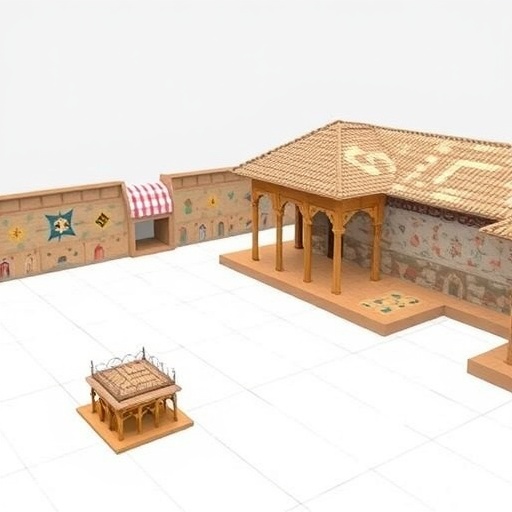In the field of cultural heritage preservation, a groundbreaking innovation is reshaping how museums and conservators protect fragile and invaluable organic artifacts. Known as the Conservation Soft Box, this new technology offers an affordable, versatile, and highly effective way to safeguard delicate objects such as mummified human remains, ancient textiles, paper documents, and wooden artifacts. Developed through years of interdisciplinary research and chemical analysis, this airtight, chemically stable enclosure promises to become a cornerstone in the future of artifact conservation, especially in regions with limited resources.
The Conservation Soft Box functions as a flexible plastic casing composed of tubular structures that securely hold a protective sheet around the object in question. Its design is both ingenious and practical: by creating a hermetic seal, it isolates the contents from external contaminants and environmental fluctuations. Within this sealed environment, internal conditions are actively managed, ensuring that the artifact remains in an optimal state for prolonged periods without requiring continuous maintenance.
At the core of the Conservation Soft Box’s efficacy is its integrated system for gas and humidity control. An activated carbon filter absorbs volatile gases emitted naturally by organic materials, preventing the buildup of harmful substances that could accelerate degradation. Simultaneously, silica gel packets calibrated to the specific conservation needs absorb and maintain ideal humidity levels within the enclosure. This precise equilibrium of humidity is vital because fluctuations can lead to irreversible damage such as cracking, warping, or microbial growth.
The journey toward perfecting the Conservation Soft Box was extensive and collaborative. Researchers engaged Eco Research, a center specializing in advanced chemical analysis, to rigorously test various materials for chemical stability and inertness. The resulting choice of plastics and filter components guarantees the box’s inside atmosphere does not chemically interact with the artifacts, effectively replicating the protective environment found in high-end museum display cases but at a fraction of the cost and complexity.
One of the primary drivers for this innovation was the need to make high-quality conservation accessible to institutions and countries with rich cultural collections but limited budgets. Traditional display cases, often made of chemically treated glass and complex, temperature-controlled systems, can cost thousands of dollars. By contrast, the Conservation Soft Box’s low-cost materials and straightforward assembly process allow for significant savings without compromising protection, producing a conservation solution accessible on a global scale.
Beyond preservation, the Conservation Soft Box is particularly suited for other vital roles in the artifact management lifecycle. For instance, the box facilitates safe transport of delicate objects by providing a cushioned, contamination-free microenvironment that minimizes stress from vibrations and external pollutants. It also allows for safe disinfection procedures when items are contaminated by mold or bacteria, using controlled atmospheres that hinder microbial growth without damaging the artifact.
The device also opens new avenues for scientific research, particularly in the analysis of volatile organic compounds (VOCs) emitted by preserved organic remains. Historically, studying these compounds has been difficult due to interference from environmental contaminants. By isolating artifacts inside a Conservation Soft Box, researchers can accurately identify VOCs such as the scents derived from resinous embalming substances found in Egyptian mummies. Such studies enhance understandings of ancient preservation techniques and cultural practices.
This innovation builds upon previous efforts at Eurac Research, which patented a passive display case about a decade ago that preserved cultural assets without requiring electric power. The Conservation Soft Box yields comparable protective results while streamlining assembly and dramatically reducing production costs. Its demand for minimal maintenance and energy makes it an environmentally sustainable alternative to traditional methods.
The potential impact of the Conservation Soft Box extends into education and capacity-building sectors as well. The research team plans to offer workshops worldwide, targeting conservators and heritage professionals interested in fabricating their own soft boxes for use in varied contexts. The aim is to empower those responsible for safeguarding vulnerable cultural heritage, especially in regions where advanced conservation facilities are scarce.
The Conservation Soft Box’s versatility is underscored by the fact that it can accommodate an array of artifact types beyond mummies—ranging from textile fragments to ancient manuscripts and delicate wooden objects. This adaptability ensures that the technology can be integrated into multifaceted conservation strategies within museums, archives, and archaeological repositories.
The research behind this innovative solution was recently unveiled at the 11th World Congress of Mummy Studies held in Cusco, Peru. The event provided an important platform to share detailed findings, gather feedback from the conservation community, and explore potential collaborations for further development and dissemination.
Looking to the future, it is clear that the Conservation Soft Box represents a paradigm shift in how heritage conservation might be approached globally. By combining scientific rigor with affordability and ease of use, it bridges a critical gap between high-end conservation technology and practical field applications. Its adoption could profoundly influence the ways in which cultural assets—particularly those most vulnerable to environmental threats—are preserved for generations to come.
Subject of Research:
Not applicable
Article Title:
The conservation soft box (CSB): An innovative, versatile, and low-cost technique to preserve cultural heritage
News Publication Date:
5-Aug-2025
Web References:
http://dx.doi.org/10.1016/j.culher.2025.07.020
Image Credits:
Eurac Research | Marco Samadelli
Keywords:
Mummified remains, Human remains, Archaeology, Anthropology




